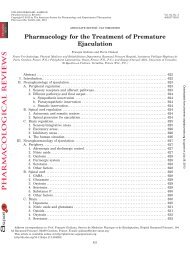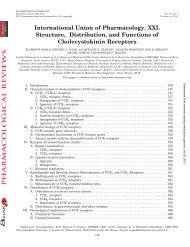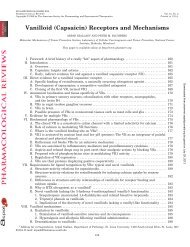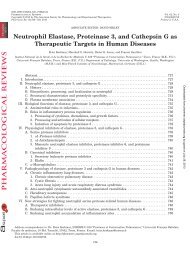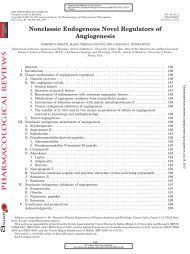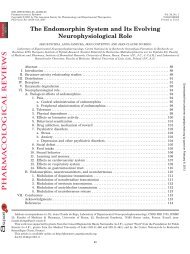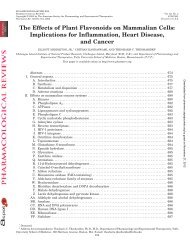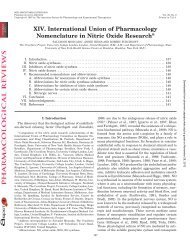Opioids, Reward and Addiction: An Encounter of Biology ...
Opioids, Reward and Addiction: An Encounter of Biology ...
Opioids, Reward and Addiction: An Encounter of Biology ...
You also want an ePaper? Increase the reach of your titles
YUMPU automatically turns print PDFs into web optimized ePapers that Google loves.
ables <strong>and</strong>/or individual characteristics contribute to<br />
whether or not an individual becomes dependent on the<br />
drug. At this point a basic emotional feature may have<br />
been altered by repeated drug use, which in turn is<br />
responsible for the need to experience the effect <strong>of</strong> the<br />
drug again <strong>and</strong> again. This need is basically <strong>of</strong> a psychic<br />
nature, but it can contain physical elements such as<br />
physical dependence. Once a person has become dependent<br />
on a drug, discontinuation <strong>of</strong> drug use is difficult.<br />
Even after a prolonged period <strong>of</strong> abstinence, addicts can<br />
relapse into their former habit <strong>of</strong> drug dependence. A<br />
factor that may be important for relapse is craving, a<br />
(intense) desire to re-experience the effects <strong>of</strong> the drug<br />
(Rankin et al., 1979; Markou et al., 1993). Drug craving<br />
can be conceptualized as the incentive motivation to<br />
self-administer a previously consumed drug. This craving<br />
may be present during continuous use <strong>of</strong> the drug<br />
<strong>and</strong> long after abstinence, <strong>and</strong> may develop on basis <strong>of</strong><br />
incentive sensitization mechanisms in which associative<br />
learning plays a role (Bolles, 1975; Stewart et al., 1984;<br />
Robinson <strong>and</strong> Berridge, 1993). Besides craving, other<br />
factors may contribute to relapse, which is the major<br />
target for treatment programs <strong>of</strong> drug addiction.<br />
II. Reinforcement <strong>and</strong> Motivation<br />
Alterations in the organism’s environment trigger<br />
sensory mechanisms <strong>and</strong> thus generate information that<br />
is conveyed to the CNS. This information <strong>and</strong> other<br />
inputs into the brain are integrated at several levels <strong>and</strong><br />
can activate or inhibit the brain output systems, including<br />
motor systems, thus eliciting behavioral changes.<br />
The purpose <strong>of</strong> these behavioral changes is the adaptation<br />
<strong>of</strong> an organism to changes in environmental conditions,<br />
with the ultimate result that survival <strong>of</strong> the organism<br />
or its species is ensured. The extreme <strong>of</strong> an<br />
environmental continuum is that the organism approaches<br />
a desirable (pleasant) <strong>and</strong> avoids a noxious<br />
(aversive) environment.<br />
The setpoint <strong>of</strong> behavioral reactions is determined by<br />
genetic factors but its value is being modulated continuously<br />
by new experiences <strong>and</strong>, as a consequence, by<br />
acquired behavioral patterns. Behavioral reactions can<br />
be acquired through the association <strong>of</strong> stimuli that are<br />
originally neutral to innate reactions. The processes involved<br />
are types <strong>of</strong> associative learning. Forms <strong>of</strong> nonassociative<br />
learning include habituation <strong>and</strong> sensitization.<br />
During habituation, the reflex reaction elicited by a<br />
nonnoxious stimulus decreases when the stimulus is<br />
presented repeatedly. Sensitization involves an increased<br />
reflex reaction to a wide range <strong>of</strong> stimuli given<br />
shortly after the presentation <strong>of</strong> an intense or noxious<br />
stimulus. Through nonassociative learning the organism<br />
learns about the properties <strong>of</strong> one particular stimulus.<br />
Two major classes <strong>of</strong> associative learning are distinguished:<br />
classical <strong>and</strong> instrumental conditioning. During<br />
classical conditioning, a concept which was intro-<br />
OPIOIDS, REWARD AND ADDICTION 345<br />
duced by Pavlov (1927), the organism learns about the<br />
relationship between one stimulus in its environment<br />
<strong>and</strong> another stimulus (the unconditioned <strong>and</strong> the “neutral”<br />
conditioned stimulus). The unconditioned stimulus<br />
activates an established reflex <strong>and</strong> thus elicits an unconditioned<br />
reaction (e.g., the presence <strong>of</strong> food in the<br />
mouth results in salivation). Before conditioning the<br />
conditioned stimulus does not elicit the unconditioned<br />
reaction. After association <strong>of</strong> the conditioned stimulus<br />
<strong>and</strong> the unconditioned stimulus, the conditioned stimulus<br />
evokes a conditioned reaction that resembles the<br />
unconditioned one (e.g., when a sound is presented repeatedly,<br />
either immediately before or while food is in<br />
the mouth, salivation will ultimately follow after the<br />
presentation <strong>of</strong> the sound). Classical conditioning allows<br />
the organism to predict the coherence between events in<br />
its environment. The conditioned stimulus has become<br />
an anticipating signal for the occurrence <strong>of</strong> the unconditioned<br />
stimulus. The conditioned response can prepare<br />
the organism to deal with the result <strong>of</strong> the unconditioned<br />
stimulus more efficiently.<br />
Instrumental conditioning, introduced by Thorndike<br />
(1913), refers to the process <strong>of</strong> learning about the relationship<br />
between a stimulus <strong>and</strong> the behavior <strong>of</strong> the<br />
organism. When a certain behavioral act is followed by a<br />
favorable change in its environment, the organism tends<br />
to repeat this behavior (law <strong>of</strong> effect). This change in<br />
environment can be the occurrence <strong>of</strong> a pleasant stimulus<br />
or the removal <strong>of</strong> an aversion or noxious stimulus. In<br />
instrumental conditioning, in contrast to classical conditioning,<br />
the (behavioral) response changes the probability<br />
that the unconditioned stimulus will appear, allowing<br />
the organism to have more or less control over its<br />
environment. Four types <strong>of</strong> instrumental conditioning<br />
can be distinguished: positive reinforcement (presentation<br />
<strong>of</strong> a pleasant stimulus), punishment (presentation<br />
<strong>of</strong> an aversive stimulus), negative punishment (removal<br />
<strong>of</strong> a pleasant stimulus), <strong>and</strong> negative reinforcement (removal<br />
<strong>of</strong> an aversive stimulus). The frequency <strong>of</strong> behavioral<br />
responses usually increases when positive or negative<br />
reinforcement is operative <strong>and</strong> decreases in the<br />
case <strong>of</strong> punishment, including negative punishment.<br />
Many studies on positive reinforcement in experimental<br />
animals use lever manipulation as the behavioral<br />
response, <strong>and</strong> the conditioning in such experiments is<br />
also termed operant conditioning. This type <strong>of</strong> conditioning<br />
is <strong>of</strong>ten investigated in the so-called “Skinner box”<br />
(Skinner, 1938). A typical experiment involves placement<br />
<strong>of</strong> a hungry animal in a box in which a horizontal<br />
lever protrudes from a wall. Pressing the lever is followed<br />
by presentation <strong>of</strong> food. The animal learns that<br />
this behavioral act is reinforced by food. Thus, when the<br />
animal is hungry <strong>and</strong> is placed in the same box it is<br />
likely to press the lever to obtain food. The behavioral<br />
act in operant conditioning is termed “operant”, <strong>and</strong> the<br />
pleasant stimulus that tends to increase the frequency <strong>of</strong><br />
the operant is called “positive reinforcer”.



